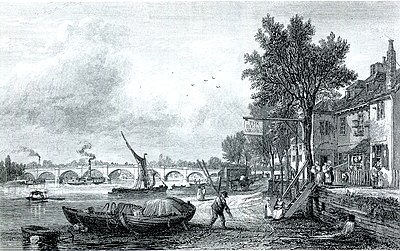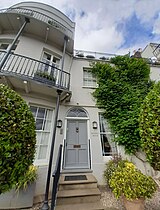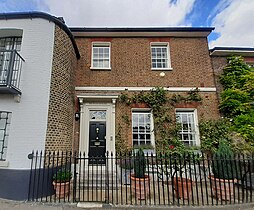Strand-on-the-Green
| Strand-on-the-Green | |
|---|---|
 Strand-on-the-Green as seen from Kew Bridge | |
Location within Greater London | |
| OS grid reference | TQ193778 |
| London borough | |
| Ceremonial county | Greater London |
| Region | |
| Country | England |
| Sovereign state | United Kingdom |
| Post town | LONDON |
| Postcode district | W4 |
| Dialling code | 020 |
| UK Parliament | |
| London Assembly | |
Strand-on-the-Green is one of Chiswick's four medieval villages, and a "particularly picturesque"[1] riverside area in West London. It is a
The area was a fishing village named "Stronde" in 1353. By the 18th century, it had become a place of river-trade with many different businesses. It became fashionable with the opening of Kew Bridge and the presence of the royal family at Kew Palace. Freight traffic declined with the opening of the Grand Junction Canal. Strand-on-the-Green became a residential area in the 20th century.
Location
Strand-on-the-Green is the most westerly part of Chiswick. It is on the north bank of the
-
Tidal flooding by the City Barge
-
Flood defences
-
Golden Salamander resting on the barge standing at low tide
History
Early origins

Over 100 human skulls, now lost, were found in the river at Strand-on-the-Green during the 19th century. Similar river skulls have been dated to around 600 BC, while ancient Roman pottery has been found in the area. The area is first named "Stronde" in 1353 (probably meaning "shore"), at which time it was a fishing village. In 1593 it was named "Strand Green"; the name had become "Strand under Green" on John Rocque's 1746 map.[1][2][3] Gradually, other river businesses set up alongside the fishermen.[3] According to the Chiswick and Brentford Local History Society:
the watermen's steps and landing stages of the gentry were cheek by jowl with the wharves built for trade by brick-makers, coal and stone merchants, maltsters, market gardeners, nurserymen, boat-builders, engineers and inn-keepers, and for the up-river depot of the water-Bailiff of the City of London.[3]
Modern era
Strand-on-the-Green is one of modern Chiswick's four medieval villages. The other three are Old Chiswick, the area around St Nicholas Church; Little Sutton; and Turnham Green.[1] The area grew in popularity when in 1759 Kew Bridge opened, displacing the ferry that had run there for centuries. The presence of the royal family at Kew Palace further helped to make the area fashionable, encouraging the wealthy to build fine houses locally, and bringing industries such as barge-building, boat repair, malt-houses, and wharves for loading and unloading river boats.[1]

Pier House Laundry, occupying much of the western end of Thames Road (between Spring Grove and Hearne Road) was built by 1860, becoming one of London's largest
The diversion of freight traffic to Brentford by the Grand Junction Canal at the start of the 19th century caused Strand-on-the-Green to decline, a process accelerated by the move of the royal family from Kew Palace to Windsor Castle. In the 20th century, Strand-on-the-Green returned to residential use, and by 1932 was called "London's last remaining village".[1]
In the
In film
The 1938 television version of The Constant Nymph is partly set on Strand-on-the-Green, backed by a still image of the river.[7] A 1940
Oliver's Island

Off Strand-on-the-Green in the River Thames is
Architecture
The Strand-on-the-Green

The Strand itself is some 500 metres of houses, forming terraces in varied styles and heights, fronting the riverside walk. The backs of the houses face Thames Road, the many small outbuildings of differing ages giving it "an interesting and varied character."[1]
Important buildings in the group begin with the "picturesque"
No. 71, Prospect House is a large three-storied late 18th century building with a bay window and curved balcony on iron columns.[1]
No. 65, Zoffany House, is Grade II* listed as one of the finest buildings in the area; it was built c. 1704. It is a three-storey house of brown brick with red dressings; it has five double-hung sash windows surrounded by
-
The Bell & Crown
-
Prospect House
-
Zoffany house
Just to the east is the 18th[1] or early 19th[16] century Magnolia House (Grade II).[1] It is a three-storey brown brick building with a parapet and double-hung sash windows, housed in flat-arched reveals. The house is distinctive in having the first and second floors with a bow front, supported by two round cast-iron columns; in the centre of this on the first floor is a French window. The windows in the bow have "good cast iron balconettes".[16] The main door has six panels and a rectangular fan window above.[16][17]
Next are The Moorings, five houses from 1930, built for the "Cottage Craftsmen"; the 18th century Compass House (Grade II); Dutch House with its gable front; the former "The Ship", a pub throughout the 19th century (Grade II); and an "impressive"[1] terrace of 5 three-story Georgian houses at nos 52 to 55 (Grade II).[1] There follow The Malthouse, nos 49 and 50 (early 19th century, Grade II); no. 44, Navigator's Cottage and no. 45, Picton House (two-storey 18th century houses, Grade II).[1]
The City Barge pub opened in the 15th century, though only some of the lower part survived the World War II bombing.[1] A 1940 land mine destroyed much of the pub and the two small cottages that were next to it, where the pub's bar now stands.[3]
-
Picton House
-
The City Barge
-
Kew Railway Bridge (Grade II listed), looking West along Strand-on-the-Green
-
Sailing Club under the ornate Kew Railway Bridge abutment
The
The Almshouses form a terrace running back from the river along an alley, Grove Row. They are described as "an attractive feature ... of a modest scale and pleasingly detailed with tall chimneys".[1] The almshouses were built in 1724 by Thomas Child as six small one-roomed houses for the poor. They were refurbished as the "Hopkin Morris Homes of Rest" in 1933, creating three two-roomed houses. The 1933 and 1724 foundation stones survive on the end wall facing the river.[1][24]
The last house of the terrace facing the river is Strand on the Green House (18th century, Grade II) at the eastern end of the riverside walk.[1] To its east is a Victorian era drinking fountain in red granite, and a short riverside footpath beside the start of Grove Park Road.[1]
-
The 18th centuryBull's Headpub
-
The Almshouses, built in 1724
Notable residents

Strand-on-the-Green has been home to a variety of distinguished people over the centuries, including the Earl of Grantham, who purchased Grove House in 1745,[3] the actress Eileen Atkins, and the novelist Margaret Kennedy, who set her bestselling[23] 1924 work The Constant Nymph there.[3] The author Nancy Mitford wrote the 1945 novel The Pursuit of Love when she lived in Rose Cottage.[3] The film director John Guillermin lived at No. 60 (The Dutch House).[3] The newspaper publisher Sir Hugh Cudlipp, and the botanist and explorer of Australia Allan Cunningham have both lived at No. 21. The painter and gallerist Joshua Compston lived at No. 75.[3] Johan Zoffany RA (1733–1810), a German neoclassical painter lived (and died) at no. 65.[25]
See also
- Chiswick High Road – the relocated commercial centre of Chiswick
- Chiswick Mall – another historic riverside street in Chiswick
References
- ^ a b c d e f g h i j k l m n o p q r s t u v w x y z aa ab ac ad "Strand on the Green Conservation Area Appraisal" (PDF). London Borough of Hounslow. May 2018. p. 6. Archived (PDF) from the original on 22 June 2020. Retrieved 22 June 2020.
- ISBN 0-948667-96-6
- ^ a b c d e f g h i j k Judges, Kathleen; Knight, Christopher (1981). "Who Was Who on Strand on the Green". Brentford & Chiswick Local History Society. Retrieved 6 July 2021.
- ^ "Huge fire tears through riverside talent agency in Chiswick". Get West London. 17 January 2016. Retrieved 17 January 2016.
- ^ Wood, Zoe; Jolly, Jasper (25 January 2019). "London Pride maker Fuller's sells beer business to Asahi for £250m". The Guardian.
- ^ "Shareholder Contacts: Registered Office: Pier House". Fuller, Smith & Turner. Retrieved 3 July 2021.
- ISBN 978-0-19-874233-3.
- ^ "River Pubs Aka Strand On The Green Issue Title - Picture Pie". British Pathé. 1940. Retrieved 5 July 2021.
- ^ "Filming Locations for Help!". The Worldwide Guide To Movie Locations. Retrieved 26 May 2008.
- ^ "Goodbye Mr Chips (1969)". Reel Streets. Retrieved 5 July 2021.
- ^ "Oliver's Island, Hounslow". Hidden London. Retrieved 17 December 2015.
- OCLC 59178433. Retrieved 17 December 2015.
- ^ "The City Barge Pub, Chiswick, London". h2g2. 10 April 2012. Retrieved 28 July 2019.
- ^ a b Historic England. "Zoffany House (1067523)". National Heritage List for England. Retrieved 6 July 2021.
- ^ "Zoffany House". Panorama of the Thames Project. Retrieved 15 July 2018.
- ^ a b c Historic England. "Magnolia House (1067522)". National Heritage List for England. Retrieved 9 July 2021.
- ^ "Magnolia House". British Listed Buildings. Retrieved 9 July 2021.
- ISBN 0-14-0710-47-7.
- ^ a b "Kew Railway Bridge". Grace's Guides. Retrieved 5 July 2021.
- ^ Historic England (25 May 1983). "Kew Railway Bridge (1065412)". National Heritage List for England. Retrieved 1 August 2020.
- ^ "Club History". Strand on the Green Sailing Club. Retrieved 5 July 2021.
- ^ Historic England. "The Bulls Head Public House (1356694)". National Heritage List for England. Retrieved 6 July 2021.
- ^ a b "Strand on the Green, Hounslow". Hidden London. Retrieved 3 July 2021.
- ^ "Hopkin Morris Homes Of Rest, Strand On The Green, Chiswick, Greater London". Historic England. Retrieved 5 July 2021.
- ^ "JOHANN ZOFFANY (1733-1810)". The Chiswick Calendar. Retrieved 10 January 2023.
Further reading
- Buckle, Jennifer (1993). A Victorian legacy : Strand-on-the-Green as it was. Portia. OCLC 59983485.

















